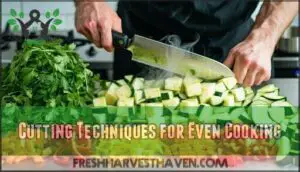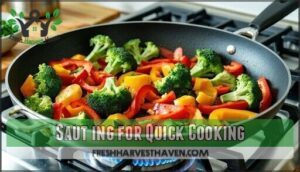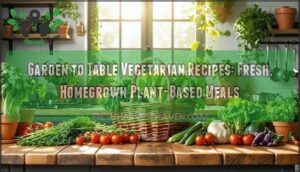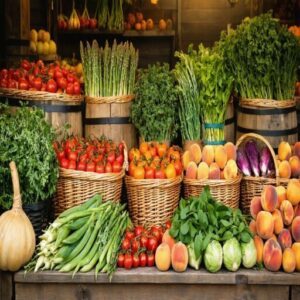This site is supported by our readers. We may earn a commission, at no cost to you, if you purchase through links.

Start by steaming to preserve up to 90% of vitamin C, or try sautéing with minimal oil for quick, vibrant results.
Roasting at 400-450°F caramelizes natural sugars, creating depth without losing essential minerals.
Don’t overlook blanching and shocking – this pro technique locks in color and texture while stopping enzyme activity.
Whether you’re grilling for smoky char or poaching in aromatic broths, each organic vegetable cooking technique serves a purpose, and the secret lies in matching your method to your vegetable’s unique structure and your desired outcome.
Table Of Contents
- Key Takeaways
- Choosing The Best Organic Vegetables
- Preparing Organic Vegetables for Cooking
- Moist Heat Cooking Methods
- Dry Heat Cooking Techniques
- Advanced Ways to Enhance Organic Vegetables
- Frequently Asked Questions (FAQs)
- What is the healthiest method to cook vegetables?
- What are 5 different methods to cook and prepare vegetables?
- What cooking method is best for vegetables?
- Which cooking technique will remove the most nutrients from vegetables?
- How do I store organic vegetables properly?
- Which organic vegetables require special preparation techniques?
- Can I mix organic and conventional vegetables safely?
- What seasonings best complement organic vegetable flavors?
- How do I prevent overcooking delicate organic vegetables?
- How do cooking methods affect organic vegetable nutrients?
- Conclusion
Key Takeaways
- Steam for maximum nutrients – You’ll preserve up to 90% of vitamin C by steaming vegetables for 3-8 minutes, compared to losing 50% through boiling
- Match cooking methods to vegetable structure – Use gentle techniques like poaching for delicate greens, while sturdy root vegetables shine with high-heat roasting at 400-450°F
- Master blanching and shocking for color retention – Drop vegetables in boiling water briefly, then plunge into ice baths to lock in vibrant colors and stop enzyme activity
- Choose vibrant, firm produce and prep properly – Select organic vegetables with bright colors and no soft spots, then wash thoroughly and cut uniformly for even cooking
Choosing The Best Organic Vegetables
You’ll get the best flavor and nutrition when you choose organic vegetables at their peak freshness and quality.
Look for vibrant colors, firm textures, and avoid any produce with soft spots or obvious blemishes that signal deterioration, ensuring you select the best organic vegetables.
Selecting Produce With Vibrant Colors
Vibrant hues signal peak freshness in organic produce.
Choose colors that practically glow with freshness—your taste buds will thank you
Deep greens in leafy vegetables and rich purples in eggplant indicate maximum nutrient density.
Color selection matters because bright, saturated tones reflect healthy growing conditions from organic farming practices.
These fresh picks contain maximum vitamins and minerals.
When choosing organic choices for your vegetable stir fry, let vibrant colors guide you toward the healthiest options available.
Understanding the benefits of seasonal produce can also help in making informed decisions about organic vegetable selection, considering peak freshness and healthy growing conditions for the best nutrient density.
Avoiding Blemishes and Soft Spots
When selecting organic produce, examine each vegetable closely for quality indicators.
Blemishes and soft spots signal deterioration that compromises both flavor and nutritional value.
Press vegetables gently to check firmness.
Avoid produce with dark patches, wrinkled skin, or mushy areas.
These damage control measures guarantee you’re getting the best from your organic farming investment while maintaining proper food safety standards and ensuring the overall nutritional value.
Considering Seasonal and Local Options
Peak flavor and nutrition happen when you choose seasonal produce from local sourcing.
Farm fresh vegetables from organic markets or community gardens offer superior taste and support your region’s organic farming practices.
Spring brings tender greens, summer delivers ripe tomatoes, fall provides hearty root vegetables, and winter offers storage crops.
Local produce travels shorter distances, retaining more nutrients than shipped alternatives, which is a key benefit of choosing local sourcing for organic farming practices.
Intended Use in Selecting Vegetables
Always consider your cooking method when doing vegetable selection at the market.
Delicate leafy greens work best for sautéed greens, while sturdy root vegetables shine in roasted roots preparations.
Match seasonal produce to your intended technique – steaming vegetables requires firm textures, whereas braising transforms tough stems into tender bites.
This freshness check approach guarantees maximum nutrient content and flavor in your healthy cooking adventures with organic food.
Preparing Organic Vegetables for Cooking
Proper preparation sets the foundation for cooking organic vegetables that taste great and retain maximum nutrients.
You’ll want to handle your fresh produce carefully from washing through storage to preserve both flavor and nutritional value, and this careful handling is crucial for the overall quality of the vegetables.
Washing and Peeling to Reduce Pesticides
Even organic vegetables can carry pesticide residues from neighboring farms or processing equipment.
Running water removes 43-77% of pesticide residues from leafy greens like lettuce. For maximum pesticide removal, scrub firm vegetables under fresh water for one minute.
Peeling removes up to 100% of surface pesticides on root vegetables and fruits, though some nutrients are lost with the skin.
Effective pesticide residue removal techniques are essential for consumer health.
Cutting Techniques for Even Cooking
Uniform cuts guarantee vegetables cook evenly and look professional.
Master julienne cutting for thin strips perfect for sautéed greens.
Use dice methods for stews with vegetable broth.
Apply proper chop techniques and consistent slice thickness.
Control your mince for aromatics.
These cooking techniques transform your organic ingredients from kitchen gardening into restaurant-quality dishes.
Storing to Maximize Freshness
Once you’ve cut your vegetables properly, smart storage keeps them fresh longer.
Store most vegetables in the refrigerator’s crisper drawer with proper humidity management. Different vegetables need different conditions to maintain their organic food freshness and preserve those valuable organic ingredients.
Understanding proper vegetable storage methods is essential for maximizing freshness.
- Refrigeration Tips: Keep leafy greens in perforated bags and store root vegetables separately to prevent moisture transfer
- Ethylene Control: Store ethylene producers like tomatoes away from sensitive vegetables to prevent premature ripening
- Humidity Management: Use the high-humidity drawer for leafy greens and the low-humidity drawer for fruits and herbs
- Root Cellars: Store potatoes, onions, and winter squash in cool, dark places with good air circulation for extended freshness
Moist Heat Cooking Methods
You’ll find moist heat methods gentle on organic vegetables, using water or steam to cook them evenly while keeping nutrients intact.
These techniques work especially well for delicate vegetables that might burn or dry out with direct heat methods, making them a preferable choice for delicate vegetables.
Boiling for Simple Preparation
Once prepared vegetables are ready, boiling offers the simplest cooking method. You’ll submerge organic ingredients in rapidly bubbling water, making it perfect for dense vegetables like potatoes and carrots.
Water quality affects taste, so use filtered water when possible. This method causes some nutrient loss through leaching, but you can minimize this by using minimal water and saving the liquid for stocks.
Vegetable texture becomes tender quickly, making boiled organic food ideal for mashing or purees. When cooking with herbs, add them during the last few minutes to preserve their flavors and avoid bitter notes from overcooked greens.
| Vegetable Type | Cooking Times | Boiling Tips |
|---|---|---|
| Root vegetables | 15-25 minutes | Start in cold water |
| Leafy greens | 2-3 minutes | Add to boiling water |
| Cruciferous | 5-8 minutes | Don’t overcook to avoid sulfur smell |
| Dense vegetables | 10-15 minutes | Test with fork for doneness |
Steaming for Nutrient Preservation
Steamer baskets reveal your organic food’s full potential by preserving up to 90% of vitamin C compared to boiling’s 50% loss.
These cooking methods maintain vegetable texture while retaining essential minerals like potassium and magnesium.
Proper steaming times of 3-8 minutes maximize nutrient retention and health benefits.
Your sauted greens can’t match steamed vegetables’ superior nutritional value and vibrant colors, which is why steaming is a better method to preserve the nutritional value.
Poaching in Aromatic Liquids
Gently poach organic vegetables in well-seasoned broths to reveal their full potential.
Aromatic spices like bay leaves and thyme transform simple liquid selection into flavor enhancement magic.
Keep poaching times short for maximum nutrient retention.
This gentle technique preserves natural ingredients while infusing wholesome eating with subtle complexity that sautéed greens can’t match.
Using proper cooking techniques is essential for retaining nutrients and flavor in organic vegetables, which is a key part of wholesome eating.
Sous Vide for Precise Cooking
Sous vide gives you complete control over temperature and timing. Your organic vegetables cook gently in vacuum-sealed bags within water baths, preserving nutrients that traditional methods destroy.
Sous vide machines maintain exact temperatures, ensuring precision cooking every time.
- Temperature control prevents overcooking while maximizing nutrient retention
- Vacuum sealing locks in natural flavors and prevents oxidation damage
- Water baths provide even heat distribution for consistent results
Using a sous vide method with sous vide techniques can help achieve perfect doneness and preserve nutrients in organic vegetables.
Dry Heat Cooking Techniques
When you use dry heat methods, you’ll concentrate your organic vegetables’ natural flavors while creating appealing textures through caramelization.
These techniques work without added moisture, allowing vegetables to develop crispy exteriors and tender interiors that retain their nutritional value, which is a key aspect of preserving the nutritional benefits.
Sautéing for Quick Cooking
Sautéing transforms organic ingredients through high heat and minimal oil.
You’ll need proper pan selection and heat control for success.
Start with medium-high heat, add oil when the pan’s hot, then introduce vegetables.
Quick recipes shine with this method.
This cooking technique preserves nutrients while developing flavors quickly.
| Sauté Tips | Best Practice |
|---|---|
| Cooking Oils | Use high smoke point oils like avocado |
| Heat Control | Medium-high prevents burning |
| Pan Selection | Wide, shallow pans work best |
Stir-Frying in a Wok
Stir-frying in a wok releases organic vegetables’ full potential through intense heat and quick cooking.
Your wok selection matters—carbon steel heats evenly at 400-600°F.
Oil choice affects flavor; peanut oil handles high heat well.
Heat control prevents steaming while vegetable prep guarantees uniform cuts. A great option is a durable cooking surface.
Sauce techniques finish dishes perfectly, preserving nutrients in your organic food recipes, using the right sauce techniques.
Grilling and Broiling for Direct Heat
Direct heat transforms organic vegetables by creating smoky, charred flavor profiles that can’t be achieved through other methods.
Set your grill temperatures to medium-high heat for most organic vegetables, around 400-450°F.
Broiling techniques work similarly, positioning vegetables 4-6 inches from the heat source. Vegetable marinades with olive oil help prevent sticking and enhance taste.
Watch carefully to avoid burning while achieving that perfect charred exterior, with smoky flavor profiles.
Roasting for Enhanced Flavors
Roasting transforms organic vegetables through high heat, creating deep flavors and caramelized surfaces. This dry-heat method concentrates natural sugars while preserving nutrients better than boiling.
Key roasting principles for organic vegetables:
- Roasting Temperatures: Use 400-450°F for ideal caramelization process
- Roasting Oils: Choose olive or avocado oil for high-heat stability
- Herb Infusion: Add rosemary or thyme during final minutes
- Vegetable Combinations: Pair root vegetables with similar cooking times
- Spacing: Don’t overcrowd pans to guarantee proper browning
Organic food quality shines through roasting, as organic farming methods produce vegetables with concentrated flavors that intensify beautifully under heat. Sautéing is a quick cooking method that works well for tender organic vegetables.
Advanced Ways to Enhance Organic Vegetables
Once you’ve mastered basic cooking methods, these advanced techniques will transform your organic vegetables into restaurant-quality dishes.
You’ll discover how to create rich gratins, tender braised vegetables, glossy glazes, and vibrant colors that make every meal memorable.
Gratin for Combining Vegetables
Gratin’s magic lies in transforming humble organic vegetables into a unified masterpiece.
This French technique layers thinly sliced vegetables with rich sauces and crispy toppings.
You’ll achieve perfect results by understanding proper vegetable layering order and selecting complementary ingredients for maximum flavor development.
| Component | Best Options |
|---|---|
| Gratin Cheese Pairing | Gruyère, aged cheddar, Parmesan |
| Cream Sauce Options | Béchamel, heavy cream, cashew cream |
| Vegetable Layering Order | Dense vegetables bottom, delicate on top |
| Breadcrumb Topping Ideas | Panko mixed with herbs, crushed crackers |
| Baking Dish Selection | Cast iron, ceramic, or enameled steel |
Braising and Stewing for Tenderizing
Two hours of gentle simmering transforms tough organic vegetables into tender perfection.
Braising benefits include enhanced flavor infusion as vegetables absorb aromatic liquids.
Stewing time varies by density – root vegetables need longer than leafy greens.
Choose liquid choices like broth or wine for depth.
Texture control comes from monitoring doneness, ensuring organic food maintains structure while becoming fork-tender.
The process involves understanding that aromatic liquids play a crucial role in the transformation of the vegetables.
Glazing for Added Flavor
Transform your organic vegetables into glossy masterpieces using glazing techniques that balance sweet vs savory flavors.
Combine organic ingredients like butter, honey, and vegetable broth with your favorite organic food choices.
This method creates healthier glazes while preserving nutrients.
Recipe ideas include maple-glazed carrots or herb-butter Brussels sprouts for elevated organic food cooking.
Blanching and Shocking for Color Preservation
Color vibrancy takes center stage when you blanch organic vegetables in rapidly boiling water.
This quick cooking method locks in nutrients while enzyme inactivation preserves that fresh-picked appearance.
Drop your organic vegetables into the boiling water, then plunge them into an ice bath within seconds.
Proper ice bath timing stops the cooking process instantly, maintaining texture retention and food quality.
This food preparation technique transforms ordinary organic food into restaurant-worthy dishes through precise food cooking control.
Frequently Asked Questions (FAQs)
What is the healthiest method to cook vegetables?
Steaming preserves the most nutrients while enhancing flavor and texture.
You’ll retain vitamins and minerals that boiling washes away.
Steam vegetables for about seven minutes over two inches of water for the best results.
What are 5 different methods to cook and prepare vegetables?
Versatile vegetable variety ventures beyond basic boiling.
You can steam for nutrient retention, roast for caramelized sweetness, sauté for quick crispness, grill for smoky char, or stir-fry for vibrant texture and flavor, which includes caramelized sweetness.
What cooking method is best for vegetables?
You’ll achieve the best results by steaming your vegetables.
This gentle method preserves nutrients, color, and texture while preventing overcooking.
Use two inches of water and steam for about seven minutes.
Which cooking technique will remove the most nutrients from vegetables?
Boiling vegetables in water leaches out the most nutrients, especially water-soluble vitamins like C and B-complex. You’ll lose up to 50% of these essential compounds when they dissolve into cooking water.
How do I store organic vegetables properly?
Picture vibrant greens wilting in your crisper drawer.
Store leafy vegetables in breathable bags with damp paper towels.
Keep root vegetables in cool, dark places.
Separate ethylene producers like tomatoes from sensitive crops.
Which organic vegetables require special preparation techniques?
Cruciferous vegetables like Brussels sprouts and broccoli need careful timing to avoid sulfur compounds.
Steam them for exactly seven minutes.
Onions require slow cooking to develop sweetness, while leafy greens need quick blanching to preserve nutrients.
Can I mix organic and conventional vegetables safely?
You can absolutely mix organic and conventional vegetables safely.
There’s no food safety risk combining them.
Just wash both thoroughly before cooking to remove dirt and residues for the best results, and remember to handle them with care to ensure safety.
What seasonings best complement organic vegetable flavors?
Salt, pepper, garlic, and herbs like thyme or rosemary enhance vegetables’ natural sweetness.
Fresh lemon juice brightens earthy flavors.
Olive oil and parmesan create rich depth without overpowering delicate organic tastes.
How do I prevent overcooking delicate organic vegetables?
Watch your vegetables closely and test doneness frequently. Steam delicate greens for 2-3 minutes, tender vegetables for 4-5 minutes. They’ll continue cooking after heat removal, so stop early.
How do cooking methods affect organic vegetable nutrients?
Like nutrients dancing on a knife’s edge, your cooking method determines whether you’ll preserve or destroy organic vegetables’ nutritional value.
Steaming retains the most vitamins and minerals, while boiling leaches nutrients into water you’ll discard, which can destroy the nutritional value.
Conclusion
Surprisingly, cooking your organic vegetables correctly requires more skill than growing them.
You’ve learned twelve organic vegetable cooking techniques that transform simple produce into nutrient-dense meals.
Each method serves specific purposes: steaming preserves vitamins, roasting develops flavors, and blanching maintains color.
You’ll maximize your investment in quality organic produce by matching cooking techniques to each vegetable’s structure and your desired outcome.
- http://www.foodandnutritionjournal.org/volume9number2/effects-of-different-cooking-methods-on-physicochemical-and-bioactive-compounds-of-selected-green-vegetables-in-north-eastern-region-bangladesh/
- https://www.uhhospitals.org/blog/articles/2023/11/raw-vs-cooked-vegetables
- https://www.wholefoodsmarket.com/tips-and-ideas/archive/nutritional-benefits-organic-fruits-and-vegetables
- https://www.theculinarypro.com/vegetable-cooking-methods
- https://www.sciencedirect.com/science/article/abs/pii/S1878450X20300950












